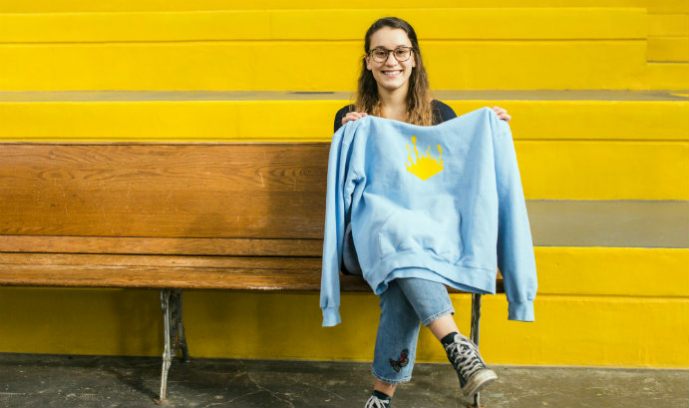Designing a Business

Sophia Eschenbach-Smith ’20, one of five students awarded the 2018 Leonard P. Pool Memorial Prize, put a design she created on hoodies and t-shirts that she then sold.
As part of a two-dimensional art course in the fall 2017 semester, Sophia Eschenbach-Smith ’20 was tasked by her Lehigh professor with creating a design out of black construction paper that could only be cut in diagonal and curved lines.
Eschenbach-Smith, an art major with minors in architecture and product design, played around with the orientation of the design until it was what she envisioned: one that she describes as defying gravity, with a diamond base that has the appearance of paint dripping upward instead of downward.
Inspired by a friend who prints designs on shirts, Eschenbach-Smith decided to put her design on hoodies and t-shirts that she then sold for a limited time, first to family and friends. Instead of a black background, she created a brightly colored graphic that can be personalized to the users’ choice of ink and apparel color.
Because of her entrepreneurship, Eschenbach-Smith was one of five students to be awarded the 2018 Leonard P. Pool Memorial Prize. The award is given to rising juniors and seniors who demonstrate entrepreneurship skills while taking classes at Lehigh, whether by running a business or creating a product.
The award, which is applied toward the winners’ Lehigh tuition, is based on the entrepreneurial spirit that typified the life and career of Air Products founder Leonard Pool, who died in 1975.
Eschenbach-Smith says she enjoyed demonstrating that art majors can contribute to the university and be recognized outside of the art department. “Everyone was really excited for me, but it was more satisfying for myself to be recognized for what I have done,” she says.
The design task was the first project assigned in the two-dimensional art course, taught by Jason Travers, professor of practice in art, architecture and design. It involved finding a solution to a cut-and-paste project in which students were only allowed to cut paper in certain ways. The tasks included only using horizontal lines, diagonal and diagonal with curved lines.
“I wanted to do a bold graphic rather than just a design,” she says, referring to how she approached the project.
Eschenbach-Smith says she taught herself how to go from design to implementation. She ordered apparel and bought screen printing supplies including emulsion sheets and a squeegee. She watched YouTube videos to learn how to print her design, including how to set up silk screens, on hoodies and t-shirts.
She says one of the challenges she encountered was that the screen broke down over time, which lengthened the process.
Initially, Eschenbach-Smith sold the apparel to friends and family, but when others asked where they could get one, she created a few more to sell. The t-shirts were $15 and the hoodies were $25. This was her first time selling her art, which she says was a great learning experience. She didn’t want to make a profit, she says, but just break even.
That her successful graphic came from a class project shows that Lehigh can help students build portfolios and give hands-on practice in any field, Eschenbach-Smith says. In the studios, she has been able to work with different kinds of art that she had not been exposed to in the past, which she says expanded her interests. She hopes to continue to add more projects to her portfolio.
After her experience with creating her own graphic clothes, Eschenbach-Smith worked as an intern at Select Design in Burlington, Vermont, where she was on the production floor using automatic and manual presses for screen printing apparel.
“It was cool to see how different it is to use my one screen with my one squegee versus a press with 12 paletes on it,” she says.
Eschenbach-Smith hopes to pursue a career in art production.
“I’ve never been into fashion or sewing or anything like that,” she says. “But seeing my graphic on someone’s hoodie was really cool and surreal.”
Story by Madison Hoff ’19
Photos by Christa Neu
Posted on:





